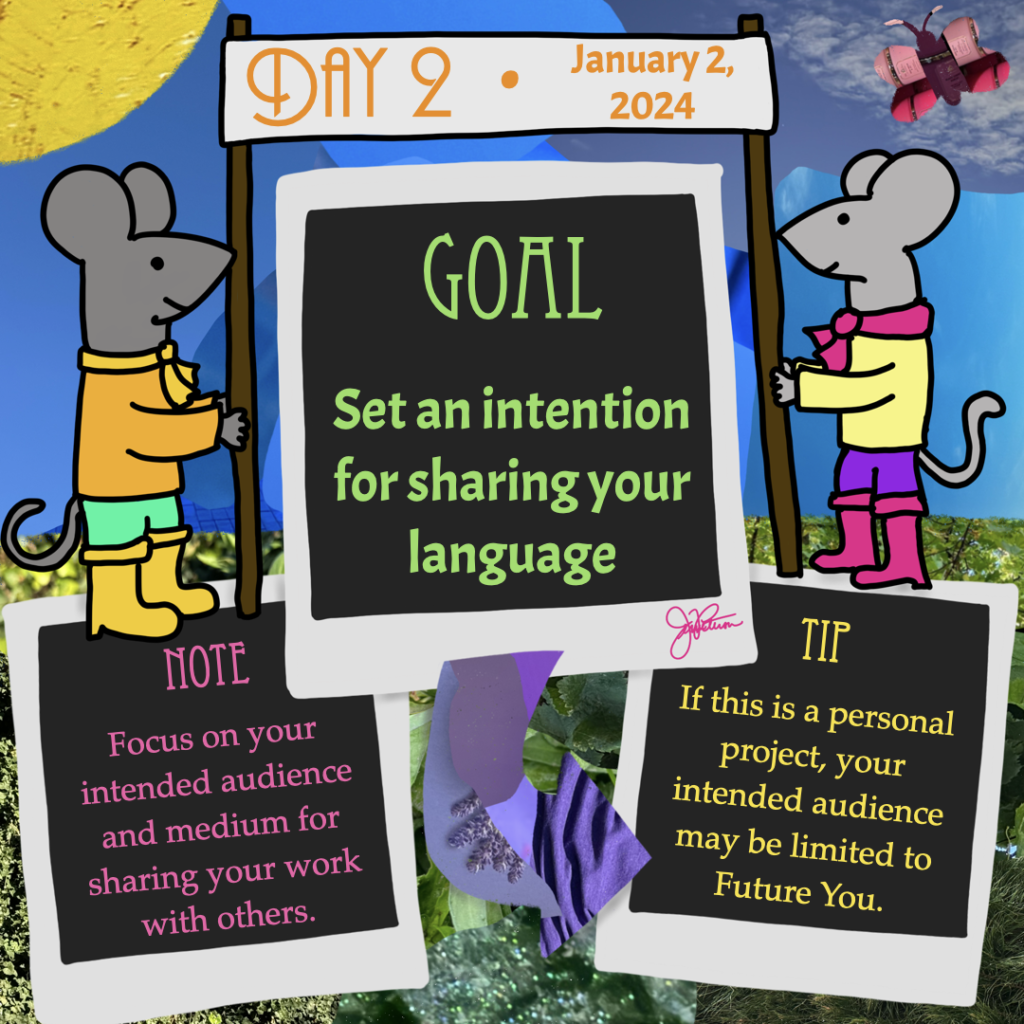
Goal: Set an intention for sharing your language
Note: Focus on your intended audience (e.g. family, friends, a linguistics professor, young adult readers across the country) and medium (e.g. written text, video recordings, lyrics in songs) for sharing your work with others.
Tip: If this is a personal project, your intended audience may be limited to Future You.
Work focus: Organize/Plan/Structure
You might find it frustrating to reach the second day of a language creation journey, only to discover you’re still not being prompted to begin crafting the language itself yet. However, as important as it is for you to have a set intention and goal for your language, it is also important to figure out how you want to share your work and who you want to share it with. These decisions are important background information that will affect the way you document your language.
If you know you want to share information about your language on social media with a wide audience of people, then you should describe its features in ways that your followers can access it. If, however, you know you want to share features of your language at a linguistics conference, you should describe your language using terms that will be meaningful to that audience. The way you choose to write about your language is honestly as important as the features you choose to include later on. You may develop an insanely cool verb system, but if you don’t document it in a way that will make it accessible to other people, no one will ever know about your verb system.
These decisions may even affect certain features you choose to incorporate in your language. For example, let’s say you want to create a language to support a novel you’re writing and will use the language to create names for characters and locations and perhaps even write dialogue for your characters. Going one step further, you know your primary audience will be native English speakers in the United States. If you want your readers to have a chance at pronouncing the names and words you create somewhat faithfully (i.e. somewhat close to what you had originally intended), then you should consider using more sounds that will be familiar to an English-speaking audience and adopt a Romanization system that allows native English speakers to guess how to pronounce the names without needing a full pronunciation guide. (Very few readers will take the time to read a pronunciation guide accompanying the book.)
That doesn’t mean you can’t use sounds unfamiliar to most English speakers—it just means you need to consider how important it is to you that people pronounce names that they only see in writing in the way that you hear it in your head.
The medium of sharing your work is important insofar that you remember to be sensitive to how other people will connect and interact with your language. If your language will primarily appear as lyrics within a musical piece, you may want to craft your language to have a certain sound or feel to fit with the musical pieces.
Even if your intended audience is yourself and no one else, you should still take language documentation seriously. I promise you that decisions you make today will make perfect sense in your mind, and you may think you will never forget why you made that choice, but… tomorrow is a different day, and Future You will rue all those half-written notes and incomplete sections detailing the features of the language.
Throughout the year, you will have days to solidify your ideas and write about them. While you can choose any method you prefer for documentation—from a trusted notebook to a series of documents on your computer—use those days wisely to describe the language features you have created and your decisions that went into the process. Once you set your intended audience and medium for sharing your conlang, I encourage you to take a moment to identify what method of documentation you think will best work for your process.
